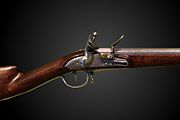This is an old revision of this page, as edited by 2600:1000:b05b:6613:ad41:31b5:d170:2bfc (talk) at 01:14, 6 July 2021 (Undid revision 1032194006 by Loafiewa (talk)). The present address (URL) is a permanent link to this revision, which may differ significantly from the current revision.
Revision as of 01:14, 6 July 2021 by 2600:1000:b05b:6613:ad41:31b5:d170:2bfc (talk) (Undid revision 1032194006 by Loafiewa (talk))(diff) ← Previous revision | Latest revision (diff) | Newer revision → (diff)Musket
| Musket Modèle 1777 | |
|---|---|
 | |
| Type | Musket |
| Place of origin | France |
| Service history | |
| In service | French Army 1777–1826 |
| Used by | France, Confederation of the Rhine, other client states of the French Empire |
| Wars | French Revolutionary Wars, Napoleonic Wars and others in the European Theatre |
| Production history | |
| Designed | 1777 |
| Manufacturer | Charleville armoury and others |
| Produced | 1777–1839 (all variants) |
| No. built | 7,000,000 |
| Variants | Modèle 1777 corrigé en l'an IX |
| Specifications | |
| Mass | 4.75 kilograms (10.5 lb) |
| Length | 1.52 metres (60 in) |
| Barrel length | 113.7 centimetres (44.8 in) |
| Cartridge | 16.54 mm, 27.19 g lead ball 12.24 black-powder propellant |
| Caliber | 17.5mm (.69 inch) musket ball |
| Action | Flintlock |
| Rate of fire | User dependent; usually 3 rounds a minute |
| Muzzle velocity | Variable 420 m/s (1,400 ft/s) |
| Effective firing range | Variable (50–100 yards) |
| Feed system | Muzzle-loaded |
The musket Modèle 1777, and later Modèle 1777 corrigé en l'an IX (Model 1777 corrected in the year 1800, or IX in the French Revolutionary Calendar) was one of the most widespread weapons on the European continent.
It was part of a weapon family with numerous variants, e.g. for the light infantry, artillery and a musketoon for the cavalry.
Modèle 1777 corrigé en l' an IX
After the French Revolutionary Wars, first consul Napoleon Bonaparte commissioned a rework; some minor modifications on the lock, bayonet and stock resulted in 1800 in the "corrected" model, also called "Modèle 1777 corrigé".
Other improvements
The Musket was further improved in 1816 and 1822.
Impact
7 million muskets were produced, including variants 1800 (an IX), 1816 and 1822, but not including muskets like the Austrian 1798 or the Prussian 1809, which were mere clones of the French 1777. Until World War I, no other firearm was produced in such large numbers.
Properly trained French infantry were expected to be able to fire three volleys a minute with the 1777. A trained infantryman could hit a man sized target at 80 yards but anything further required an increasing amount of luck and the musket became wildly inaccurate at long range. Compared to the British Brown Bess, it fired musket balls that fitted more tightly into the barrel resulting in a better accuracy but a lower rate of fire and more fouling issues.
The Grande Armée marched into the German countries and left approx. 750,000 muskets retreating in 1815; until about 1840, French weapons were used in Germany.
Details of the musketSee also
- Charleville musket for predecessors of the Modèle 1777
- Brown Bess – English musket, "counterpart" to the 1777 in the Napoleonic Wars
Literature
- Hans-Dieter Götz: Militärgewehre und Pistolen der deutschen Staaten 1800–1870, 2nd edition, Stuttgart, 1996, ISBN 3-87943-533-2 (in German)
References
- Moore, Richard Napoleonic Guide: Weapons of War: Infantry 2006
External links
| Preceded byCharleville musket | French Army rifle 1777–1826 |
Succeeded byDelvigne rifle 1826 |


